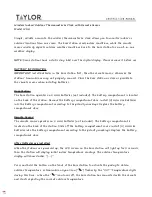
For best setup connection, keep the base station and remote close to each other while trying to
connect. Keep away from other electronic equipment that may interfere with the connections,
such as mobile phones, appliances, computers, refrigerators, TVs, etc.
Indoor temperature readings update on the base station approximately every 30 seconds. The
remote sensor transmits outdoor temperature readings to the base station approximately every
57 seconds. A red light flashes on the sensor when it sends a transmission signal.
NOTE
: While the base station is in “analyzing” mode, some functions (such as Clock Setting) may
not be operational, or using the functions will interrupt the transmission reception. Once the
“analyzing” mode is complete, the other functions will become operational.
LOW BATTERY
Base Station
: Replace the batteries if readings grow dim or irregular.
Remote Sensor
: Replace the batteries if the red light on the sensor stops flashing approximately
every 57 seconds, or if transmission signals seem weak or irregular.
IMPORTANT:
Always replace both batteries at the same time; do not mix old and new batteries.
Do not mix alkaline, standard (carbon-zinc) or rechargeable (ni-cad, ni-mh, etc.) batteries.
TIP:
When the temperature falls below freezing point, alkaline batteries used in outdoor stations
may freeze, lowering their voltage supply and effective range. Use of Lithium batteries is
recommended in extremely cold or hot locations.
WARNING:
Batteries may pose a choking hazard. As with all small items, do not let children
handle batteries. If swallowed, seek medical attention immediately.
PRECAUTION:
Do not dispose of batteries in fire. Batteries may explode or leak. Remove the
batteries if the stations will not be used for a long period of time.
NOTE:
Please recycle or dispose of batteries per local regulations.
DISPLAYING THE WEATHER STATION
Base Station:
Pull out the bottom of the table stand located on the back of the base station to set it on a flat
surface.
Place the base station indoors in a well-ventilated location away from direct sunlight.
Remote Sensor:
Table top – pull out stand to place the sensor on a flat surface.
Wall – use the keyhole on the back of the remote to hang on a wall with a nail or screw (not
included).

























